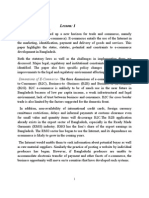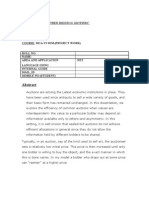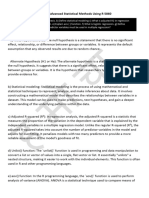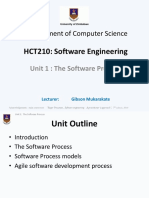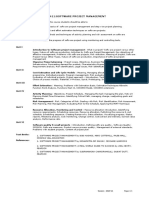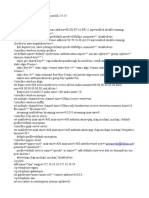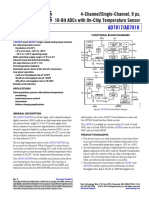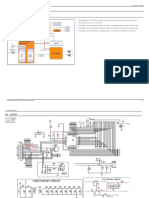0 ratings0% found this document useful (0 votes)
607 viewsChapter 1 (1.3-Adapting The Generic Product Development Process)
This document discusses different types of product development processes and how to adapt the generic process for different types of products. It outlines technology-push, platform, process-intensive, customized, high-risk, quick-build, and complex system products. For each type, it provides a brief definition and example to illustrate how the generic development process may need to be modified.
Uploaded by
Muhammad Asraf AzmiCopyright
© © All Rights Reserved
Available Formats
Download as PDF, TXT or read online on Scribd
0 ratings0% found this document useful (0 votes)
607 viewsChapter 1 (1.3-Adapting The Generic Product Development Process)
This document discusses different types of product development processes and how to adapt the generic process for different types of products. It outlines technology-push, platform, process-intensive, customized, high-risk, quick-build, and complex system products. For each type, it provides a brief definition and example to illustrate how the generic development process may need to be modified.
Uploaded by
Muhammad Asraf AzmiCopyright
© © All Rights Reserved
Available Formats
Download as PDF, TXT or read online on Scribd
You are on page 1/ 19
DEVELOPMENT PROCESSES
AND ORGANIZATION
MEM531
INTEGRATED PRODUCT DESIGN 1
1.3 ADAPTING THE GENERIC
PRODUCT DEVELOPMENT
PROCESS
Technology-Push Products
Begins with a new proprietary technology and looks for an
appropriate market in which to apply this technology.
Involve basic materials or process technologies because they are
commonly deployed in many applications.
In the planning phase a given technology is matched with a
market opportunity followed by generic development process.
A technology-push product will only succeed if:
The technology used gives a clear competitive advantage in
meeting customer needs.
Suitable alternative technologies are unavailable for the
competitors to utilize.
Example of Technology-Push Products
Platform Products
The new product will be built around an established technological
subsystem (a technology platform).
Example: Tape transport mechanism in the Sony Walkman, the
Apple Macintosh operating system, Polaroid instant film.
Slightly similar to technology-push product development starts
with an assumption that the product concept will utilize a particular
technology.
The only difference is a technology platform has already being
used and proven useful in meeting customer needs.
Therefore much simpler to develop compared if the technology
were developed from scratch.
Example of Platform Products
Process-Intensive Products
Include semiconductors, foods, chemicals and paper.
Characteristics of the product are highly constrained by the
production process.
Certain production process will give different product characteristic.
In many cases the products are produced in very high volumes and
are bulk.
Either an existing production process must be specified from the
beginning, or both product and process must be developed
together from the beginning.
Example of Process-Intensive Products
Customized Products
Customized products have slight variations of existing
configurations.
Developed in response to a specific order by a customer.
Involves setting values of design variables such as physical
dimensions and materials.
Similarity of projects allows for a streamlined and highly structured
development process.
Example of Customized Products
High-Risk Products
Have big uncertainties of failure related to the technology or
market.
Technical risk will the product function properly?
Market risk will the customer like what the team develops?
Budget and schedule risk can the team complete the project on
time and within the budget?
Reducing these risks by addressing the risk at early product
development stages concept testing using prototypes.
These risks have to be monitored regularly expecting that the risk
will be reduced over time and not being postponed (wait and see).
Example of High-Risk Products
Quick-Build Products
Rapid modeling and prototyping enables many design-build-test
cycle to be made.
This allows rapid iteration (more flexible and responsive product
development process) a.k.a spiral product development process.
Detail design and testing phases are repeated a number of times
until the product is completed or time/budget runs out.
Customer may ne involved in the testing process after one or more
cycle trial version of software.
When this happen, normally all the expected detail design features
have been incorporated into the evolving product
Example of Quick-Build Products
Complex Systems
System must be decomposed into several subsystems and many
components.
These subsystems and components are developed by many teams
working in parallel.
Involves larger-scale products such as automobiles and airplanes.
Detail design of the components is a highly parallel process in
which the development teams work at once.
Example of Complex Systems
Products Development Process Flow
Involves the development of market-pull, technology-push,
platform, process intensive, customized and high-risk products.
Each stage is followed by a review to confirm that the stage is
completed and to determine whether the project proceeds.
Involve the quick-build products.
Detail design, prototyping and testing are repeated a number of
times.
Involve the complex systems.
Works of the subsystems and components are decomposed into
parallel stages of work.
You might also like
- Question: Explain The Main Elements of E-Business StrategyNo ratings yetQuestion: Explain The Main Elements of E-Business Strategy6 pages
- Water Level Indicator With Numeric Display - Final0% (1)Water Level Indicator With Numeric Display - Final17 pages
- Service Discovery Middleware: Finding Needed Services100% (1)Service Discovery Middleware: Finding Needed Services52 pages
- Chapter Three Purchasing and Materials ManagementNo ratings yetChapter Three Purchasing and Materials Management15 pages
- DSS - Ch01 Decision Support System Lecture NotesNo ratings yetDSS - Ch01 Decision Support System Lecture Notes7 pages
- Cyber-Crimes National/international: Mphasis Citibank Scam CaseNo ratings yetCyber-Crimes National/international: Mphasis Citibank Scam Case5 pages
- Credit Card Fraud Detection Using Adaboost and Majority Voting100% (1)Credit Card Fraud Detection Using Adaboost and Majority Voting4 pages
- Consumer Behaviour 2 PPT at Bec Doms 2009 Bagalkot Mba0% (1)Consumer Behaviour 2 PPT at Bec Doms 2009 Bagalkot Mba12 pages
- Software Project Management QuestionnaireNo ratings yetSoftware Project Management Questionnaire18 pages
- Fuzz Testing (Fuzzing) Tutorial - What Is, Types, Tools & ExampleNo ratings yetFuzz Testing (Fuzzing) Tutorial - What Is, Types, Tools & Example8 pages
- III Year V Sem Cs6503 Theory of ComputationNo ratings yetIII Year V Sem Cs6503 Theory of Computation44 pages
- Equity of Cybersecurity in the Education System: High Schools, Undergraduate, Graduate and Post-Graduate Studies.From EverandEquity of Cybersecurity in the Education System: High Schools, Undergraduate, Graduate and Post-Graduate Studies.No ratings yet
- Chapter 3 Design of Products & ServicesNo ratings yetChapter 3 Design of Products & Services15 pages
- Supervisor Assesement Form: Faculty of Mechanical Engineering Universiti Teknologi Mara (Uitm Penang)No ratings yetSupervisor Assesement Form: Faculty of Mechanical Engineering Universiti Teknologi Mara (Uitm Penang)6 pages
- Pricelist Amd + Asrock + Intel SSD +pny PT Emedia Devices 281124No ratings yetPricelist Amd + Asrock + Intel SSD +pny PT Emedia Devices 28112427 pages
- Setting Mikrotik Untuk Warnet DG Feature Web-Proxy NyaNo ratings yetSetting Mikrotik Untuk Warnet DG Feature Web-Proxy Nya10 pages
- Examen de Certificación Práctica CCENT Nº1No ratings yetExamen de Certificación Práctica CCENT Nº119 pages
- Manual PAW-AW-MBS-H User Manual v1.2 r1.3 enNo ratings yetManual PAW-AW-MBS-H User Manual v1.2 r1.3 en21 pages
- enhancing-functionality-and-user-experience-through-usercentered-design-in-architectural-designNo ratings yetenhancing-functionality-and-user-experience-through-usercentered-design-in-architectural-design2 pages
- Small Size, Big Power: Fast, Accurate, Versatile XRF AnalysisNo ratings yetSmall Size, Big Power: Fast, Accurate, Versatile XRF Analysis2 pages
- Multiple Image Steganography Using LSB DCT TechniqueNo ratings yetMultiple Image Steganography Using LSB DCT Technique5 pages
- Lecture 6 - Industrial Instrumentation and Actuators - 3No ratings yetLecture 6 - Industrial Instrumentation and Actuators - 328 pages
- Microelectronics 2nd Edition Jerry C. Whitaker - Download the ebook in PDF with all chapters to read anytimeNo ratings yetMicroelectronics 2nd Edition Jerry C. Whitaker - Download the ebook in PDF with all chapters to read anytime57 pages
- Sbi Po & Ibps Po Mains Day - 28 e 169788874118No ratings yetSbi Po & Ibps Po Mains Day - 28 e 16978887411840 pages
- Group 1 - Korea National Stat Office KCRM Technology - PP PDFNo ratings yetGroup 1 - Korea National Stat Office KCRM Technology - PP PDF12 pages
- Categorizing Traditional Chinese Painting Images: Lecture Notes in Computer Science October 2004No ratings yetCategorizing Traditional Chinese Painting Images: Lecture Notes in Computer Science October 20049 pages
- Velocidad de Red HyperV Lento Desactivar VMQNo ratings yetVelocidad de Red HyperV Lento Desactivar VMQ11 pages
- Keyboard Interfacing in 8085 - ComputerSCNo ratings yetKeyboard Interfacing in 8085 - ComputerSC4 pages
- Question: Explain The Main Elements of E-Business StrategyQuestion: Explain The Main Elements of E-Business Strategy
- Water Level Indicator With Numeric Display - FinalWater Level Indicator With Numeric Display - Final
- Service Discovery Middleware: Finding Needed ServicesService Discovery Middleware: Finding Needed Services
- Cyber-Crimes National/international: Mphasis Citibank Scam CaseCyber-Crimes National/international: Mphasis Citibank Scam Case
- Credit Card Fraud Detection Using Adaboost and Majority VotingCredit Card Fraud Detection Using Adaboost and Majority Voting
- Consumer Behaviour 2 PPT at Bec Doms 2009 Bagalkot MbaConsumer Behaviour 2 PPT at Bec Doms 2009 Bagalkot Mba
- Fuzz Testing (Fuzzing) Tutorial - What Is, Types, Tools & ExampleFuzz Testing (Fuzzing) Tutorial - What Is, Types, Tools & Example
- Modern Intelligent Instruments - Theory and ApplicationFrom EverandModern Intelligent Instruments - Theory and Application
- Equity of Cybersecurity in the Education System: High Schools, Undergraduate, Graduate and Post-Graduate Studies.From EverandEquity of Cybersecurity in the Education System: High Schools, Undergraduate, Graduate and Post-Graduate Studies.
- Supervisor Assesement Form: Faculty of Mechanical Engineering Universiti Teknologi Mara (Uitm Penang)Supervisor Assesement Form: Faculty of Mechanical Engineering Universiti Teknologi Mara (Uitm Penang)
- Pricelist Amd + Asrock + Intel SSD +pny PT Emedia Devices 281124Pricelist Amd + Asrock + Intel SSD +pny PT Emedia Devices 281124
- Setting Mikrotik Untuk Warnet DG Feature Web-Proxy NyaSetting Mikrotik Untuk Warnet DG Feature Web-Proxy Nya
- enhancing-functionality-and-user-experience-through-usercentered-design-in-architectural-designenhancing-functionality-and-user-experience-through-usercentered-design-in-architectural-design
- Small Size, Big Power: Fast, Accurate, Versatile XRF AnalysisSmall Size, Big Power: Fast, Accurate, Versatile XRF Analysis
- Multiple Image Steganography Using LSB DCT TechniqueMultiple Image Steganography Using LSB DCT Technique
- Lecture 6 - Industrial Instrumentation and Actuators - 3Lecture 6 - Industrial Instrumentation and Actuators - 3
- Microelectronics 2nd Edition Jerry C. Whitaker - Download the ebook in PDF with all chapters to read anytimeMicroelectronics 2nd Edition Jerry C. Whitaker - Download the ebook in PDF with all chapters to read anytime
- Group 1 - Korea National Stat Office KCRM Technology - PP PDFGroup 1 - Korea National Stat Office KCRM Technology - PP PDF
- Categorizing Traditional Chinese Painting Images: Lecture Notes in Computer Science October 2004Categorizing Traditional Chinese Painting Images: Lecture Notes in Computer Science October 2004






